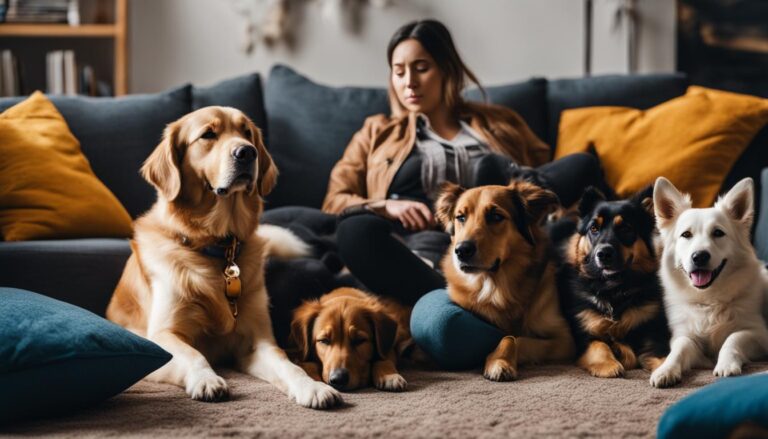As a dog owner, I often wonder if my furry friend really cares about the taste of his food. Does he enjoy the flavors or is he simply eating to satisfy his hunger? These questions led me to delve into the fascinating world of canine taste preferences and how dogs perceive flavors.
Can dogs truly experience the same range of tastes that we do? Do they have specific preferences for certain flavors? What role does their sense of smell play in their perception of flavors? Join me as we uncover the answers to these questions and more.
Key Takeaways:
- Dogs’ evaluation of food palatability and preference is important to the pet food industry.
- They rely heavily on their sense of smell to determine the palatability of food.
- Dogs have taste buds that can detect sweet, sour, salty, and bitter flavors.
- Their sense of taste is less discriminating than humans, but they can still taste and appreciate flavors.
- Further research is needed in measuring odor preferences in dogs.
Understanding Canine Taste Perception
Dogs have a sense of taste, but it is not as refined as that of humans. They have taste buds that can detect the four primary taste sensations – sweet, sour, salty, and bitter. However, dogs have fewer taste buds compared to humans, with an average of about 1,700 taste buds. Despite this, they can still taste and appreciate flavors. Taste perception is important in determining the palatability of dog food, as it influences their food choices. (do dogs have a sense of taste, dog food palatability, importance of taste in dog food, dog taste receptors)
Dogs also have special taste receptors for water, which are located at the tip of their tongue. This allows them to taste and distinguish water from other liquids. While their sense of taste is less discriminating than humans, dogs rely heavily on their sense of smell to determine the palatability of food. Smell and taste are closely related, and dogs use their sense of smell to enhance their perception of flavors. (do dogs have a sense of taste, dog food palatability, dog taste receptors)
“Dogs have taste buds that can detect different flavors, and their preferences for certain tastes can influence their food choices.”
Food companies take into account dogs’ taste preferences when developing palatable dog food options. They conduct taste tests with hundreds of dogs to determine their flavor preferences and create food products that dogs will enjoy. Understanding canine taste perception is crucial in providing dogs with food that they find enjoyable and nutritious. (do dogs have a sense of taste, importance of taste in dog food, dog food palatability)
Table: Comparison of Canine and Human Taste Perception
| Canine Taste Perception | Human Taste Perception | |
|---|---|---|
| Sweet | Can detect sweet flavors | Can detect sweet flavors |
| Sour | Can detect sour flavors | Can detect sour flavors |
| Salty | Can detect salty flavors | Can detect salty flavors |
| Bitter | Can detect bitter flavors | Can detect bitter flavors |
| Taste Buds | Fewer taste buds compared to humans | More taste buds compared to dogs |
| Water Taste Receptors | Special receptors located at the tip of the tongue | No specialized water taste receptors |
The Role of Smell in Dog Food Preferences
When it comes to understanding how dogs perceive flavors, their sense of smell plays a crucial role. Dogs have an incredibly strong sense of smell, with up to one million times more sensory glands in their noses compared to humans. They can taste foods through their sense of smell, utilizing a special organ along their palate. This close relationship between smell and taste means that dogs heavily rely on their sense of smell to determine the palatability of food.
Aromatic foods are particularly enticing to dogs, as the strong smell makes them more appealing. In fact, dogs are more likely to eat foods that have a pleasant smell. This is why meat-based foods, which have a distinctive aroma, are often preferred by dogs. Smell also influences dogs’ preferences for different flavors, allowing them to discern between different food options.
In the words of Dr. Emily Sullivan, a veterinarian specializing in animal behavior, “Smell is the key to a dog’s heart. They rely on their sense of smell to determine whether a food is desirable or not, and a strong aroma can make all the difference.”
While research on the specific odorants that influence palatability in dogs is limited, it is clear that dogs’ sense of smell plays a significant role in their food preferences. As dog owners, it is important to consider the olfactory aspect of canine taste perception when selecting and offering food to our furry friends.
Table: The Influence of Food Smell on Canine Food Preferences
| Food Option | Smell Intensity | Preference |
|---|---|---|
| Meat-based food | Strong | Preferred |
| Plant-based food | Mild | Less preferred |
| Fish-flavored food | Pungent | Preferred by some dogs |
Canine Taste Preferences and Food Variety
When it comes to taste preferences, dogs are no different from humans. Just like us, they have their own individual likes and dislikes. Some dogs may prefer the rich flavor of beef, while others may enjoy the sweetness of chicken. Understanding a dog’s taste preferences is important in providing them with a diet that they find palatable and enjoyable.
Food variety also plays a crucial role in dogs’ eating habits. Dogs can quickly become bored with the same food day in and day out. Just imagine eating the same meal every day for years – it would get monotonous, right? The same goes for dogs. Offering them a variety of flavors and textures keeps their taste buds stimulated and prevents mealtime boredom.
Most dogs enjoy trying new foods and flavors. They are curious creatures who are always willing to explore their taste preferences. It’s like a culinary adventure for them. Warm, moist foods often tend to be more appealing to dogs, as they mimic the texture and temperature of fresh, homemade meals. On the other hand, cold, dry foods may not be as enticing to them.
| Food Variety Tips for Dogs |
|---|
| 1. Introduce new flavors gradually to avoid digestive upset. |
| 2. Mix in different types of meats and proteins to provide a range of flavors. |
| 3. Incorporate fruits and vegetables for added taste and nutrition. |
| 4. Offer a combination of dry kibble and wet canned food for texture variety. |
| 5. Consult with your veterinarian for guidance on creating a balanced and varied diet. |
While food variety is generally well-received by most dogs, some can be more hesitant to try new foods. This could be due to their upbringing and exposure to different flavors as puppies. Dogs that were raised without much food variety may be more resistant to accepting new flavors. However, with patience and persistence, most dogs can be encouraged to expand their palate and embrace a wider range of tastes.
Dogs’ Perception of Salt
When it comes to taste, dogs have a unique relationship with salt. Unlike humans, dogs do not have a strong preference for salt due to their evolutionary history as meat-eating animals. Meat naturally contains enough salt to meet their body’s needs. However, dogs can still taste salt and appreciate its flavor. Their preference for meat flavors is likely influenced by their evolutionary diet, which consisted of a high proportion of meat. Dogs have different taste preferences depending on their species and what they evolved to eat.
While dogs can taste salt, their sense of taste is less discriminating compared to humans. They have fewer taste buds, with an average of 1,700 taste buds compared to humans’ 9,000. This means that dogs may not perceive the nuances of saltiness as strongly as we do. However, their ability to taste salt is still important, as it adds to the overall flavor profile of the food they consume.
It’s important to note that while dogs can taste salt, excessive consumption of salt can be harmful to their health. Too much salt can lead to dehydration and other health issues. It’s always best to consult with a veterinarian to ensure that your dog’s diet is balanced and meets their nutritional needs without excessive salt content.
“While dogs may not have a strong preference for salt, they can still taste it and appreciate its flavor. As meat-eating animals, their preference for meat flavors is likely influenced by their evolutionary diet.”
The Relationship Between Food Odors and Canine Food Preferences
When it comes to dog food preferences, odors play a significant role. Dogs rely on their sense of smell to distinguish between different flavors and use odor stimuli as cues to determine their preferred food. The aroma of a food can enhance its palatability for dogs, making it more enticing and enjoyable. Research suggests that dogs can discern between various food flavors based on their smell, highlighting the strong connection between odor and canine food preferences.
While specific studies on the odorants that influence palatability in dogs are limited, it is clear that dogs’ ability to differentiate between flavors is closely tied to their sense of smell. Dogs possess a highly developed olfactory system, with up to one million times more sensory glands in their noses compared to humans. This heightened sense of smell allows dogs to detect subtle odor differences in food, influencing their preferences and choices.
Understanding the importance of food odor in canine food preferences can help us develop more appealing and palatable dog food options. By creating foods with enticing aromas, we can enhance the overall eating experience for dogs and ensure they consume a balanced and nutritious diet.
The Role of Aromas in Canine Food Preferences
Research has shown that dogs use their sense of smell to discern between food flavors. Aromatic foods, such as those with strong meat odors, are more likely to be preferred by dogs. The smell of a food can make it more attractive and appetizing, leading dogs to consume it more eagerly. Therefore, when formulating dog food, it is essential to consider the aroma and select ingredients that contribute to a pleasant smell.
| Table: Factors Affecting Canine Food Preferences | |
|---|---|
| Dog’s sense of smell | Highly developed and crucial for food preferences |
| Aromas in food | Influence palatability and overall eating experience |
| Preference for meat-based foods | Dogs are naturally inclined towards flavors found in their evolutionary diet |
In conclusion, food odors strongly influence canine food preferences. Dogs rely on their sense of smell to determine the palatability of food and use odor cues to differentiate between flavors. By understanding and incorporating appealing aromas in dog food, we can enhance the overall eating experience for dogs, ensuring they enjoy their meals and receive necessary nutrition.
Assessing Canine Food Preferences
When it comes to understanding dog taste preferences and assessing canine food preferences, there are several methods that can be used. One common technique is the 2-bowl test, where dogs are presented with two bowls containing different foods, and their preferences are measured based on the food they consume. This test provides insights into dogs’ preferences among different food products, as dogs often consume more of the food they choose first.
Another method used to assess canine food preferences is the cognitive palatability assessment protocol. In this method, dogs are trained using objects representing different food products, and their choice between the objects indicates their food preferences. This approach allows researchers to understand dogs’ preferences in a controlled environment and gather valuable data on their taste perception.
In addition to these methods, paired stimulus assessments and simple hand touch responses have been used to evaluate food preferences in dogs. These techniques provide further insights into dogs’ preferences and their reactions to different foods.
Assessing Canine Food Preferences
| Method | Description |
|---|---|
| 2-Bowl Test | A test where dogs are presented with two bowls containing different foods, and their preferences are measured based on the food they consume. |
| Cognitive Palatability Assessment Protocol | A method where dogs are trained using objects representing different food products, and their choice between the objects indicates their food preferences. |
| Paired Stimulus Assessments | A technique that involves presenting dogs with paired food stimuli and observing their responses to determine their preferences. |
| Simple Hand Touch Responses | A method where dogs are trained to touch a specific stimulus associated with a particular food, indicating their preference. |
These methods help researchers gain insights into dogs’ taste perception and their preferences for different foods. By understanding dogs’ food preferences, pet food companies can develop more palatable and enjoyable food options for our furry friends.
Canine Odor Preferences and Food Choice
Dogs rely heavily on their sense of smell to make food choices. Odors play a crucial role in determining their food preferences and palatability. Certain odorants can enhance the appeal of food to dogs, making it more enticing and enjoyable for them. While research on specific odor preferences in dogs is limited, studies have shown that dogs can discern between different flavors based on their smell.
One notable finding is that dogs use their sense of smell to distinguish between foods flavored with different meats. The aroma of a food can significantly influence a dog’s food choice. However, methods to measure food odor preferences in dogs are still lacking, and further research is needed in this area. Understanding the importance of odor in dog food preferences can help pet food companies develop more appealing and palatable food options for dogs.
“Dogs rely heavily on their sense of smell to make food choices.”
“One notable finding is that dogs use their sense of smell to distinguish between foods flavored with different meats.”
The Importance of Odor in Dog Food Preferences
The sense of smell is a powerful tool for dogs when it comes to food choices. Their sensory glands in their noses are up to one million times more abundant than humans, allowing them to detect even subtle scent cues. Dogs can differentiate between different flavors based on their smell, and odors can significantly impact the palatability of food for them. A strong and appealing aroma can make a food more enticing to a dog, increasing the likelihood that they will eat it.
While dogs have taste buds that can detect sweet, sour, salty, and bitter flavors, their sense of taste is less discriminating than their sense of smell. Their preferences for certain flavors are influenced by their evolutionary history and their individual experiences. By understanding the importance of odor in dog food preferences, pet food companies can create products that not only meet the nutritional needs of dogs but also provide them with an enjoyable eating experience.
Table: Odor Preferences in Dog Food
| Food Flavor | Odor Preference |
|---|---|
| Beef | Strong preference |
| Chicken | High preference |
| Fish | Moderate preference |
| Lamb | Moderate preference |
Note: The table above illustrates general odor preferences in dogs for common food flavors. Individual dogs may have variations in their preferences based on breed, past experiences, and exposure to different flavors.
Dogs’ Reactions to Food Versus Smell
Dogs’ sense of taste is an important factor in their food preferences, but their sense of smell greatly influences their perception of flavors. While dogs have the ability to taste different foods, their sense of smell plays a crucial role in determining their food choices. Being able to discern and appreciate various flavors relies heavily on their olfactory abilities. A strong aroma can make a food more enticing to a dog, and they are more likely to eat foods that have a pleasant smell.
When it comes to taste, dogs have taste buds that can detect basic tastes, such as sweet, sour, salty, and bitter. However, their sense of taste is much less powerful than their sense of smell. Dogs can taste foods without relying on their sense of smell, but their ability to discern between different flavors is limited. Smell is a significant factor in determining dogs’ food preferences and their willingness to eat certain foods.
Research has shown that dogs’ sense of smell is much stronger than their sense of taste. Dogs have up to one million times more sensory glands in their noses compared to humans, allowing them to detect a wide range of odors. This powerful sense of smell allows dogs to distinguish between different food flavors based on their smell and use odor stimuli as cues to determine their preferred food. The olfactory stimuli can significantly enhance the palatability and appeal of food to dogs.
In conclusion, while dogs can taste and appreciate different flavors, their sense of smell greatly influences their perception of food. The aroma of food plays a significant role in determining dogs’ food preferences and their willingness to eat certain foods. Dogs’ strong sense of smell allows them to discern between different flavors and enhances the overall palatability of food for them.
Dogs’ Individual Taste Preferences
Every dog has its own unique taste preferences. Just like humans, dogs have their favorite flavors and foods that they enjoy the most. Factors such as breed, past experiences, and exposure to different flavors can influence a dog’s taste preferences. While there are general trends in taste preferences, such as dogs having a preference for meat flavors, each individual dog may have their own unique likes and dislikes when it comes to food.
Some dogs may be more adventurous with their food choices and enjoy trying new flavors, while others may be more selective and prefer certain types of food. It’s important for dog owners to pay attention to their furry friend’s preferences and provide them with a diet that they enjoy and find palatable. Offering a variety of flavors and textures can help keep mealtime exciting for dogs and prevent them from getting bored with their food.
Understanding a dog’s individual taste preferences is not only important for their enjoyment but also for their overall nutrition. Dogs are more likely to eat food that appeals to their taste buds, ensuring that they receive the necessary nutrients to stay healthy and happy. Dog food companies take into account dogs’ taste preferences when developing their products, creating palatable options that cater to different tastes. By offering a range of flavors and consulting with a veterinarian, dog owners can ensure that their furry friends get the most out of their meals.
Table: Common Dog Taste Preferences
| Taste Preference | Description |
|---|---|
| Meat flavors | Dogs often have a preference for meaty flavors such as chicken, beef, and lamb. |
| Sweet flavors | While dogs have a less sensitive sweet tooth than humans, some dogs may still enjoy sweeter flavors like fruits. |
| Savory flavors | Dogs may prefer savory flavors like cheese, bacon, or peanut butter. |
| Texture preferences | Some dogs may have specific texture preferences, such as enjoying crunchy kibble or soft, moist foods. |
It’s important to note that individual dog taste preferences can vary, and not all dogs will have the same preferences. Some dogs may have unique flavor preferences that differ from the general trends. Understanding and catering to a dog’s individual taste preferences can help ensure that they enjoy their meals and maintain a healthy appetite. Paying attention to what flavors and textures your dog enjoys can make mealtime a pleasurable experience for both you and your furry friend.
The Importance of Palatability in Dog Food
When it comes to choosing dog food, palatability is a crucial factor to consider. Dogs are more likely to eat food that is palatable and enjoyable to them. Just like humans, dogs have taste buds that allow them to detect different flavors, including sweet, sour, salty, and bitter. Their taste buds, although fewer in number compared to humans, play a significant role in their food preferences.
But taste alone is not the only determining factor for palatability in dog food. Dogs also heavily rely on their sense of smell. Their sense of smell is much stronger than their sense of taste, with up to one million times more sensory glands in their noses compared to humans. The aroma of food greatly influences a dog’s perception of its palatability. Highly aromatic foods are more enticing to dogs, and they are more likely to eat foods that have a strong smell.
To ensure that dog food is palatable, dog food companies conduct taste tests with hundreds of dogs. These tests help them understand the flavor preferences of dogs and develop food options that cater to those preferences. By developing palatable foods, dog food companies not only ensure that dogs enjoy their meals but also provide them with the necessary nutrition for their overall health and well-being.
| Benefits of Palatable Dog Food | Importance of Taste in Dog Food |
|---|---|
| Increases food intake | Enhances appetite |
| Improves digestion | Encourages proper hydration |
| Promotes overall health and well-being | Increases acceptance of different flavors and textures |
Ensuring that dog food is palatable is not just about making mealtime enjoyable for dogs. It also has important implications for their health and nutrition. Dogs that find their food palatable are more likely to consume an adequate amount of food, leading to better overall nutrition. Moreover, palatable food can improve digestion and ensure proper hydration, as dogs are more likely to eat and drink when their food is appealing to them. Thus, the importance of palatability in dog food cannot be overstated.
Conclusion
In conclusion, dogs do care about taste, although their sense of taste is not as refined as that of humans. Dogs have taste buds that can detect sweet, sour, salty, and bitter flavors, as well as special taste receptors for water. However, they have fewer taste buds compared to humans, which affects their ability to discern between different tastes.
Furthermore, dogs’ sense of taste is closely intertwined with their strong sense of smell. They rely heavily on their sense of smell to determine the palatability of food and to distinguish between different flavors. Aromas play a significant role in dogs’ food preferences, and foods with strong smells are more enticing to them.
It’s important to note that dogs have individual taste preferences influenced by factors such as breed, past experiences, and exposure to different flavors. While there are general trends in taste preferences, each dog may have its own unique preferences. Understanding a dog’s taste preferences and developing palatable food options that cater to them are key in ensuring that dogs enjoy their meals and receive proper nutrition.
Overall, by understanding canine flavor preferences and the factors that influence dogs’ taste perception, we can provide dogs with food that they find enjoyable and satisfying. This knowledge helps in creating a diet that meets their nutritional needs while also appealing to their taste buds.
FAQ
Do dogs have taste buds?
Yes, dogs have taste buds that can detect sweet, sour, salty, and bitter flavors.
How does a dog’s sense of taste compare to that of humans?
Dogs have fewer taste buds than humans and their sense of taste is less discriminating.
What role does smell play in a dog’s food preferences?
Dogs rely heavily on their sense of smell to determine the palatability of food and they use odor cues to discriminate between preferred and non-preferred foods.
What are some factors that can influence a dog’s taste preferences?
Breed, past experiences, and exposure to different flavors can influence a dog’s taste preferences.
Do dogs have a preference for salt?
Dogs do not have a strong preference for salt due to their evolutionary history as meat-eating animals.
How can canine food preferences be assessed?
Canine food preferences can be evaluated using methods such as the 2-bowl test, cognitive palatability assessment protocol, and paired stimulus assessments.
Do dogs have individual taste preferences?
Yes, each dog has its own individual taste preferences influenced by factors such as breed, past experiences, and exposure to different flavors.
Why is palatability important in dog food?
Dogs are more likely to eat food that is palatable and enjoyable to them, and taste plays a significant role in determining the palatability of dog food.
How does a dog’s sense of smell influence their perception of taste?
Dogs’ sense of smell greatly influences their perception of flavors, and they can taste foods through their sense of smell.
Why is understanding canine flavor preferences important?
Understanding canine flavor preferences helps ensure that dogs enjoy their meals and receive proper nutrition.









